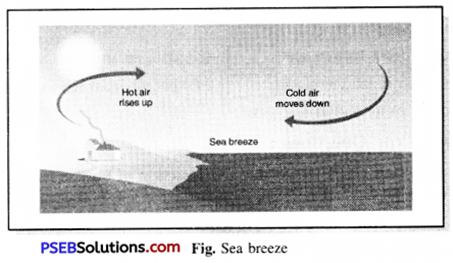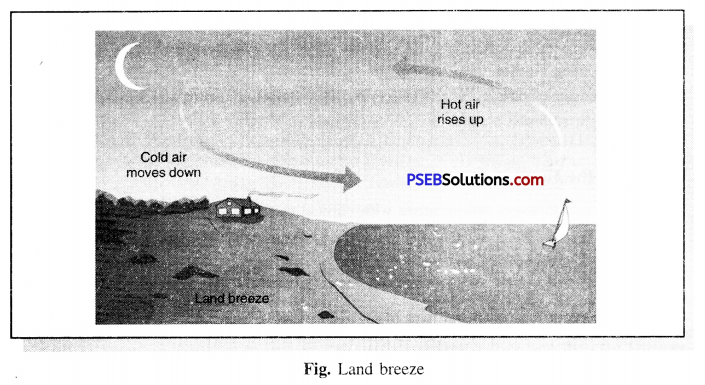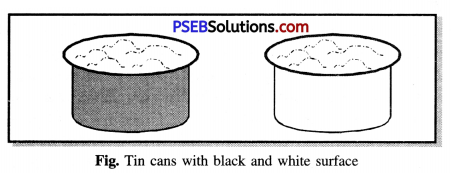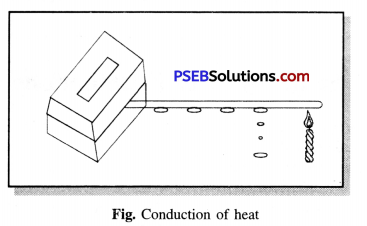Punjab State Board PSEB 7th Class Science Book Solutions Chapter 4 Heat Textbook Exercise Questions and Answers.
PSEB Solutions for Class 7 Science Chapter 4 Heat
Science Guide for Class 7 PSEB Heat Intext Questions and Answers
Think and Answer (Textbook Page No. 37)
Question 1.
The normal temperature of our body is ……………… .
Answer:
The normal temperature of our body is 37°C.
Question 2.
The clinical thermometer can measure temperature above 45°C. (T/F)
Answer:
False.
![]()
Think and Answer (Textbook Page No. 39)
Question 1.
Thermometer should be held from its bulb.(T/F)
Answer:
False.
Question 2.
The thermometer should not touch the ………………. of the beaker.
Answer:
The thermometer should not touch the bottom or sides of the beaker.
Think and Answer (Textbook Page No. 40)
Question 1.
The handle of cooking vessels are good conductor of heat. (True/False)
Answer:
False.
Question 2.
The handle of electric iron is good conductor of heat. (True/False)
Answer:
False.
Think and Answer (Textbook Page No. 42)
Question 1.
The ventilators in the rooms are used to expell cold air. (True/False)
Answer:
False.
Question 2.
The liquids are always heated from the bottom. (True/False)
Answer:
True.
Think and Answer (Textbook Page No. 44)
Question 1.
We wear light coloured clothes in winter. (True/False)
Answer:
False.
Question 2.
Dark coloured clothes absorbs less heat. (True/False)
Answer:
False.
![]()
PSEB 7th Class Science Guide Heat Textbook Questions and Answers
1. Fill in the blanks:
(i) The hotness of an object is a measured by its …………………….
Answer:
Temperature
(ii) The mode of heat transfer without any medium is called ………………….. .
Answer:
Radiation
(iii) Air is ………………….. conductor of heat.
Answer:
bad
(iv) The normal temperature of the human body is ……………………. °C.
Answer:
37°C
2. Write True or False:
(i) Metals are insulators of heat.
Answer:
False
(ii) Sea breeze arises due to conduction.
Answer:
False
(iii) We get heat from the sun by radiation.
Answer:
True
(iv) Wool is good conductor of heat.
Answer:
False
![]()
(v) Range of clinical thermometer is 35° C to 42°C.
Answer:
False
3. Match the Column ‘A’ with Column ‘B’:
| Column ‘A’ | Column ‘B’ |
| 1. Land breeze blows during
2. Sea breeze blows during 3. We prefer light coloured clothes in 4. We prefer dark coloured clothes in |
(a) winter
(b) night (c) daytime (d) summer |
Answer:
| Column ‘A’ | Column ‘B’ |
| 1. Land breeze blows during
2. Sea breeze blows during 3. We prefer light coloured clothes in 4. We prefer dark coloured clothes in |
(c) daytime
(b) night (d) summer (a) winter |
4. Choose the Correct Answer:
Question (i)
Temperature of human body is:
(a) 100°C
(b) 0°C
(c) 37° C
(d) 98°C.
Answer:
(c) 37° C.
Question (ii)
Which is bad conductor of heat ?
(a) Aluminium
(b) Iron
(c) Copper
(d) Wood.
Answer:
(d) Wood.
Question (iii)
One litre of water at 30°C is mixed with one litre of water at 50°C. Then temperature of mixture will be :
(a) 80°C
(b) More than 50°C but less than 80°C’
(c) 20°C
(d) Between 30°C and 50°C
Answer:
(d) Between 30°C and 50°C.
Question (iv)
A wooden spoon is dipped in a cup of ice cream. Its other end:
(a) becomes cold by the process of conduction.
(b) becomes cold by the process of convection.
(c) becomes cold by the process of radiation.
(d) does not become cold.
Answer:
(d) does not become cold.
Question (v)
Land breeze is:
(a) cool air from land to sea
(b) cool air from sea to land
(c) hot air from land to sea
(d) hot air from sea to land.
Answer:
(a) cool air from land to sea.
Short Answer Type Questions
Question (i)
State the condition which determine the direction of flow of heat.
Answer:
When two objects are in contact with each other, the heat is transmitted from the object at higher temperature to the object at a lower temperature.
![]()
Question (ii)
What is clinical thermometer ? Write its range.
Answer:
Clinical thermometer. Clinical thermometer is a device by which a human body temperature is measured. It is also called Medical thermometer’s range in from 35°C to 42°C.
Question (iii)
What is the use of kink in a clinical thermometer ?
Answer:
Medical thermometer has a kink (bend) just above the bulb, the function of which is to prevent the mercury level from falling because of its weight. If kink is not present there then the mercury level will drop so that the human temperature will not be measured accurately.
Question (iv)
What is Lab thermometer ? Write its range.
Answer:
Lab Thermometer. An instrument used to measure the temperature of objects other than human beings (or living things) is called Lab thermometer. The range of lab thermometer is usually 10°C to 110°C.
Question (v)
Why do we prefer dark clothes in winters and light one in summers ?
Answer:
Darker fabrics absorb more heat than light coloured fabrics. So in winter we wear dark coloured clothes to keep our body warm by absorbing more heat, whereas light coloured clothes absorb lesser amount of heat and are also good reflector so our body does not get much heat.
Question (vi)
Why do we wear woollen clothes in winters ?
Answer:
Air is trapped in the wool fibres. Since air is a bad conductor of heat, so it does not allow heat to be transmitted to the cold environment outside. That is why we feel warm in winter by wearing woollen clothes.
6. Long Answer Type Questions:
Question (i)
What are the various modes of heat transfer ? Explain.
Answer:
There are three modes of heat transfer :
1. conduction.
2. convection,
3. radiation.
1. Conduction.
It is that method of heat transfer in which heat is transmitted from the hotter end to the colder end of the object without the actual movement of the heated partilces. Solids are heated by this method.
2. Convection.
It is the process of heat transfer due to the actual movement of the heated particles of liquid or gas. Liquids and gases are heated by this method.
3. Radiation.
It is the process in which heat is transmitted directly from the ource of heat or hot object to a cold object without medium in between them. In other words no medium is required for heat radiation
![]()
Question (ii)
Explain the formation of sea breeze and land breeze in coastal areas ?
Answer:
Sea breeze.
During day time the ground is heated by the heat of the sun, which causes the ground air to heat up, roll and rise. Cold air from the ocean begins to rush towards the ground to take it’s place. The warm air from the land moves towards the sea to complete the cycle. The wind that blows from the ocean to the land is called the sea breeze.

Land breeze.
Due to higher heat absorption capacity the water cools down more slowly than the land, so cool air from the land starts rushing from the land towards the sea at night. This is called land breeze.

PSEB Solutions for Class 7 Science Heat Important Questions and Answers
1. Fill in the blanks:
(i) The degree of hotness of an object is determined by its …………………
Answer:
temperature
(ii) Temperature of boiling water cannot be measured by a ………………. thermometer.
Answer:
clinical
(iii) Temperature is measured in degree ……………… .
Answer:
Celsius
(iv) A cold steel spoon is dipped in a cup of hot milk. It transfers heat to its other end by
the process of ………………..
Answer:
conduction
(v) Clothes of …………………. colours absorb more heat than light coloured clothes.
Answer:
dark
2. Match the Column ‘A’ with Column ‘B’:
| Column ‘A’ | Column ‘B’ |
| (i) Medical thermometer
(ii) Black coloured objects (iii) Woollen clothes (iv) Transfer of heat (v) Light coloured clothes |
(a) From high temperature to low temperature
(b) In winter (c) In summer (d) Better absorbent and radiator (e) To measure the temperature of human beings. |
Answer:
| Column ‘A’ | Column ‘B’ |
| (i) Medical thermometer
(ii) Black coloured objects (iii) Woollen clothes (iv) Transfer of heat (v) Light coloured clothes |
(e) To measure the temperature of human beings
(d) Better absorbent and radiator (b) In winter (a) From high temperature to low temperature (c) In summer |
3. Choose the Correct Answer:
Question (i)
We can measure temperature with clinical thermometer
(a) From 30°C to 42°C
(b) From 35°C to 42°C
(c) From 35°C to 45°C
(d) None of these.
Answer:
(b) From 35°C to 42°C.
![]()
Question (ii)
The reliable measure of heat of an object is :
(a) The heat of that object
(b) The degree of hotness or coldness of that object
(c) The physical touch
(d) None of the above.
Answer:
(b) The degree of hotness or coldness of that object.
Question (iii)
The range of laboratory thermometer is :
(a) -10°C to 100°C
(b) 35°C to 42°C
(c) -10°C to 110°C
(d) 94°F to 108°F.
Answer:
(c) ~10°C to 110°C.
Question (iv)
Heat from sun reaches us by the process of :
(a) conduction
(b) convection
(c) radiation
(d) None of the above.
Answer:
(c) radiation.
Question (v)
Heat is transferred in liquids and gases by :
(a) conduction
(b) radiation
(c) convection
(d) None of the above.
Answer:
(c) convection.
Question (vi)
Clinical thermometer is filled with :
(a) Water
(b) Lead
(c) Mercury
(d) Air.
Answer:
(c) Mercury.
Question (vii)
What kind of clothes do we wear in summer ?
(a) Cotton
(b) Silky
(d) Wool.
(c) Jute
Answer:
(a) Cotton.
4. State True or False:
(i) We wear both light and dark clothes in summer.
Answer:
False
![]()
(ii) In coastal areas, the wind blowing from the sea towards the coast at night is called land breeze.
Answer:
False
(iii) Woollen garments provide warmth in winter as wool fibres traps in air.
Answer:
True
(iv) Heat transfer between liquids and gases is by convection method.
Answer:
True
(v) The thermometer should be washed with lukewarm water before use to measure temperature.
Answer:
False
Very Short Answer Type Questions
Question 1.
What is temperature ?
Answer:
Temperature. The degree of hotness or coolness of an object is its temperature.
Question 2.
What is thermometer ?
Answer:
Thermometer. It is a device used to measure the temperature of an object.
Question 3.
Name two types of thermometers.
Answer:
- Clinical thermometer and
- Laboratory thermometer.
![]()
Question 4.
Which metal is used in thermometers ?
Answer:
Mercury (Hg).
Question 5.
Which scales are used to measure temperatures ?
Answer:
Two scales are mainly used which are (i) Celsius scale and (ii) Fahemheit scale.
Question 6.
What is range of clinical thermometer ?
Answer:
35°C to 42°C.
Question 7.
Why is a thermometer jerked before taking temperature of a person ?
Answer:
To bring the mercury level below 35°C.
Question 8.
What is normal body temperature of healthy person ?
Answer:
37°C.
Question 9.
Name the thermometer used for noting weather temperature.
Answer:
Maximum-Minimum thermometer.
Question 10.
What is range of laboratory thermometer ?
Answer:
-10°C to 110°C.
![]()
Question 11.
Which solution is used to wash thermometer before and after use ?
Answer:
Antiseptic solution.
Question 12.
How are laboratory thermometers read ?
Answer:
In vertically upright position.
Short Answer Type Questions
Question 1.
When cold milk is added to hot tea, how does the heat transfer take place ?
Answer:
When cold milk is added to hot tea. the two come in contact with each other. The transfer of heat energy takes place from hot molecules of tea to cold molecules of milk by the process called convection.
Question 2.
What are the main conditions necessary for the flow of heat ?
Answer:
Conditions for the flow of heat. The following are three conditions responsible for the flow of heat from one place to another or from one body to another body :
- The two substances should be in contact with each other.
- The temperature of both the substances should be different.
- The heat flows from hot to cooler substance.
Question 3.
If a spoon is held over fire, it becomes hot after sometime. Describe the process of heating up.
Answer:
We know that in a solid the molecules are packed close together. When one end of the spoon is held over the fire, the molecules of material of spoon absorb the heat energy and begin to vibrate rapidly. These molecules handover heat energy to the neighbouring molecules, in turn, cause their neighbouring molecules to vibrate. This process continues along the length of the spoon and energy is transferred from the hotter part to the colder part. After sometime, the other end of the spoon also becomes hot.
Question 4.
Why is it preferred to wear bright clothes in summer and dark clothes in winter ?
Answer:
Dark coloured clothes are good absorbers of heat as compared to white clothes. The dark coloured clothes absorb the heat falling on them and become wanner. So we feel warm in winter by wearing these clothes. On the other hand, white clothes reflect heat coming from the sun. That is why, we prefer to wear bright clothes in summer and dark clothes in winter.
Question 5.
Define conduction. Why the handles of cooking utensils are made of insulators ?
Answer:
Conduction. The mode of transfer of heat in which heat is transferred from one particle to another without the actual motion of the particles, is called conduction.
The handles of cooking utensils are made up of insulating materials because they do not allow heat to flow through them. So heat cannot reach our body and thus our hand is prevented from burning.
Question 6.
Define radiation.
Answer:
Radiation. The process of transfer of heat from one body to another without heating the intervening medium, is called radiation. No medium is needed for the transference of heat by this process.
![]()
Question 7.
Distinguish between heat and temperature.
Answer:
Differences between heat and temperature.
TABLE
Question 8.
What is convection ? Give two practical applications of convection of heat.
Answer:
Convection.
The process of transference of heat in which heated gas or a liquid particles actually move from one place to another, is called convection. All the liquids and gases are heated by the method of convection.
Practical applications :
- When a stove is lighted, the air in contact with the hot stove becomes warm. On being heated, it expands and becomes lighter. As a result, it rises upwards and the cool air from its surrounding comes to take its place.
- The ventilation of ordinary buildings is due to convection.
Question 9.
As soon as the tube is removed from the source of heat, the level of liquid drops. How is this avoided in the thermometer that doctors use ?
Answer:
It is seen that the level of liquid fails in a narrow-tube (capillary tube) when it is removed from the source of heat. But when the doctor’s thermometer is removed from the source of heat, the level of mercury does not fall by itself. It is because a kink is provided in the tube of clinical thermometer which prevents mercury from falling down due to its own weight.
Question 10.
Discuss why wearing more layers of clothing during winter keeps us warm than wearing just one thick piece of clothing.
Answer:
Different layers of clothing trap air inside them. Air is a poor conductor of heat so it prevents the flow of heat from our body to the cold surrounding and keeps us warm.
Long Answer Type Questions
Question 1.
Give an experiment to show that black bodies are good absorbers and good raidators.
Answer:
Experiment. Take two tin cans of the same size. Paint one of them black and other white from outside. Pour equal amount of water in each can. Now place them in the sun for about an hour. When we touch water in the tin cans we find that the water in the black tin has become warmer than that in the other tin. Since the size of the tins is the same, this shows that black body has absorbed more heat radiations than the other one.

You can also do the reverse experiment by taking equal amount of hot water in each can. Leave the cans in a shady place for 10 minutes and record the temperature of each can. You would find the water in the dark had cooled down more. Thus, we conclude that black bodies are good absorbers and also good radiators of heat.
Question 2.
Give an experiment to show the transfer of heat by conduction.
Answer:
Experiment. Take a flat aluminium rod. Fix some iron nails on this rod with the help of molten wax. Clamp this rod in a stand as shown in the figure.
Heat one end of the rod with the help of spirit lamp. The iron nails drop one by one, starting from the hot end. It shows that heat is transferred slowly from one end of the rod to the other end by conduction.

Conduction of heat takes place from the hot part of the object to its colder parts; or from one hot object to a colder object, happens only if:
- the two parts are in contact, and
- their temperatures are different.